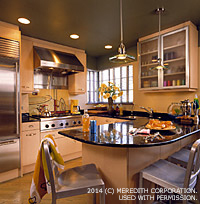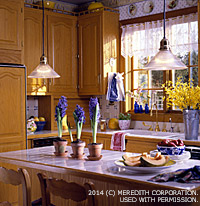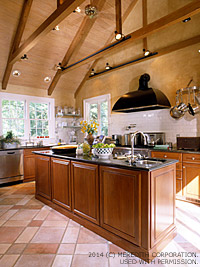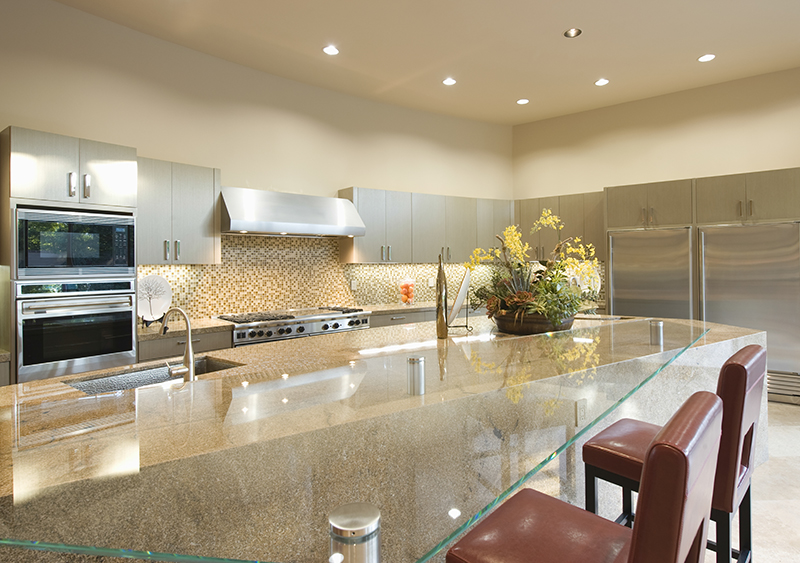 Remodeling your kitchen can be one of the best ways to increase the value of your home. Updated appliances, a well thought-out floor plan, and welcoming design and colors are the love of any potential homeowner—aka prospective home buyer. Find out how best to plan for and pay for your next kitchen update with our guide to understanding options and funding.
Remodeling your kitchen can be one of the best ways to increase the value of your home. Updated appliances, a well thought-out floor plan, and welcoming design and colors are the love of any potential homeowner—aka prospective home buyer. Find out how best to plan for and pay for your next kitchen update with our guide to understanding options and funding.
The project budget for your kitchen remodeling can help you navigate the dozens of decisions you’ll have to make. Read, ask questions, make phone calls, surf the Internet, gather product literature, bug friends who’ve remodeled—do everything you can to get informed. The more you know, the better you’ll be able to make wise choices during the planning stages.
Budget vs.Home Value
First, limit spending to about 15 percent of your home’s value. Most real estate agents say that sellers can recoup close to 90 percent of kitchen remodeling costs, but the project will be a good investment only if the spending scale makes sense relative to the house’s total worth.
Big Expenses
Second, figure that the cost of goods (appliances, countertops, cabinets, flooring, and so on) will add up to one-half to two-thirds of the total. Prices for these items are fairly easy to determine, so plug those figures into the budget early on. Earmark the remaining money for labor, design, and contracting services, permit fees, and so on. If listing all the details seems difficult, stand in your existing kitchen and write down everything that’s installed there: light fixtures, windows, molding, and so on. This won’t prevent omissions, but it will make them less likely. Factor the age of your home into the equation as well. Some changes may require modifications or structural upgrades to an older house.
Get Early Estimates
To quickly get a bead on typical costs for kitchen remodeling, go to where the action is. Visit appliance stores and home centers. Pester the sales staff with questions. Contact local kitchen design centers, and ask to see samples of work they’ve done in your price range. Not only can you see what your remodeling dollars will buy, but you also can assess the quality and value of their services before you spend a dime. Respect the worth of their time as professionals and don’t misrepresent your intentions or abuse their helpfulness, but keep in mind that it’s their job to sell, not yours to buy. If they convince you their services are valuable, then sign up.
Help Is Out There

Third, if the sheer number of choices overwhelms you, spend a little up front to bring in a design professional. This goes double if you’re considering structural changes. Even a modest one-time consulting fee can get you valuable information about your options. Better still, a pro will be more likely to mention details that a homeowner might forget amid the big picture. You’ll budget for countertops, certainly, but what about a new sink, faucet, and disposal? Does the ceramic tile you chose for the floor require cement-board underlayment? These costs might stay hidden while you prepare a rough estimate, but they’ll surface with a vengeance when you tally your final expenses. The time to get a range of opinions and advice is before the demolition crew shows up.
Without a complete and detailed plan developed before the kitchen renovation begins, you may get swept into a spending spiral of unbudgeted extras, such as a larger island or expensive hardware selected under pressure at the last minute. If your plan includes precise dimensions and specific products, the cost estimate can be quite accurate, and you’ll be able to verify that everything you want is available. Doing some or all of the work yourself will, of course, change the budget forecast, but to help with that decision, costs for professional services can be estimated ahead of time. A designer will charge a fee—usually around 6 percent of project cost—to develop a plan for your kitchen, but that plan may feature money-saving ideas and efficiencies. As for the construction and product installation, you can improve your odds of getting high-quality work if you get word-of-mouth referrals for tradespeople and ask for proof of licensing and insurance. Pass on anyone who balks at this request. Bear in mind that independent businesspeople are at risk just as you are. Most can match clients’ “bad contractor” horror stories with tales of their own—about inflexible or indecisive customers, unpaid invoices, and other problems—so be consistent, prepared, and available during the project, even if it’s not large or complex. Common sense rules the day. Designers who understand and respect your wants, needs, and spending limits are most likely to produce cost-effective plans that make you happy. As for contractors, fee schedules vary, but most ask for a big slice of the price—perhaps 40 percent—when the contract is signed. As the work progresses, you’ll owe installments. These numbers vary, so make sure the details are spelled out in writing in your contract, which should also include a work completion schedule.
Sample Remodeling Budgets
 Let’s say your kitchen measures about 10 x 12 feet. How much would it cost to remodel it yourself? In most areas of the country, you can get a cosmetic kitchen upgrade for as little as $2,500 in products. That includes new cabinet doors, laminate countertops, vinyl flooring, a stainless-steel sink and a chrome faucet. A mid-level do-it-yourself kitchen from the home center could bump the starter cost to over $6,500. At this level, you’re getting better-grade hardwood cabinets, ceramic-tile countertops and flooring, a coated-steel sink, a faucet with pullout head, new appliances, and track lighting. Moving up the price scale to about $15,000, your do-it-yourself home-center kitchen could include pricier semi-custom cabinets, laminate or ceramic-tile flooring, a cast-iron sink, a designer faucet, better appliances, and canister lighting. Granite or solid-surfacing countertops could also make it into this budget, but neither is a do-it-yourself feature. Installation, plumbing, and electrical work would not be covered by the low or midrange budget, but the high-dollar version would likely allow for some of those services. It really depends on the choices you make for cabinetry, countertops, fixtures, and other big-ticket items. The same goes for appliances. Outfit a typical kitchen with new residential appliances, and you can keep those receipt totals at less than $2,500. Splurge on high-end professional units, and your entire $15,000 budget can disappear before you even pick a color scheme for the cabinets and countertops. If you have your new kitchen professionally installed, the numbers will look a little different. Generally speaking, the biggest slices of your remodeling budget will go toward cabinets, countertops, and installation costs. Depending on style and features, cabinets can account for as much as half the cost of a professionally designed and installed kitchen. But these are, after all, the choices that will be made during your planning stage. The actual renovation will always contain surprises, so sort out whatever details you can up front. And leave a little padding in the budget. Just in case.
Let’s say your kitchen measures about 10 x 12 feet. How much would it cost to remodel it yourself? In most areas of the country, you can get a cosmetic kitchen upgrade for as little as $2,500 in products. That includes new cabinet doors, laminate countertops, vinyl flooring, a stainless-steel sink and a chrome faucet. A mid-level do-it-yourself kitchen from the home center could bump the starter cost to over $6,500. At this level, you’re getting better-grade hardwood cabinets, ceramic-tile countertops and flooring, a coated-steel sink, a faucet with pullout head, new appliances, and track lighting. Moving up the price scale to about $15,000, your do-it-yourself home-center kitchen could include pricier semi-custom cabinets, laminate or ceramic-tile flooring, a cast-iron sink, a designer faucet, better appliances, and canister lighting. Granite or solid-surfacing countertops could also make it into this budget, but neither is a do-it-yourself feature. Installation, plumbing, and electrical work would not be covered by the low or midrange budget, but the high-dollar version would likely allow for some of those services. It really depends on the choices you make for cabinetry, countertops, fixtures, and other big-ticket items. The same goes for appliances. Outfit a typical kitchen with new residential appliances, and you can keep those receipt totals at less than $2,500. Splurge on high-end professional units, and your entire $15,000 budget can disappear before you even pick a color scheme for the cabinets and countertops. If you have your new kitchen professionally installed, the numbers will look a little different. Generally speaking, the biggest slices of your remodeling budget will go toward cabinets, countertops, and installation costs. Depending on style and features, cabinets can account for as much as half the cost of a professionally designed and installed kitchen. But these are, after all, the choices that will be made during your planning stage. The actual renovation will always contain surprises, so sort out whatever details you can up front. And leave a little padding in the budget. Just in case.
Costs of a Complete Redo
These costs are based on two kitchens: one is a moderate 15 x 15 size. At the low end of the budget scale, you will spend at least $14,500 to $17,000 on ready-made cabinets, budget appliances, and flooring. Premium appliances, custom cabinets, and other quality materials can push your expenditures from $21,000 to nearly $40,000. For a larger kitchen (more than 300 square feet) you will likely spend at least $20,000 for standard cabinets and appliances. If money is no object, the costs of a new kitchen could easily reach $38,000 to $75,000. Design pros recommend that you put your money into the hardest-working and most permanent features of the kitchen, especially the cabinets and countertops. Accents, such as hardware and backsplashes, can be upgraded later, as can appliances and plumbing or light fixtures. Here’s a designer-suggested checklist to help you stretch your budget:
- Mix it up. Don’t be afraid to combine high- and low-end products, such as granite on the island and laminate countertops elsewhere.
- Don’t overdo highlights. One strong design feature on each side of the room—a glass-front cabinet or a striking light fixture—can be more effective than a jumble vying for attention.
- Don’t box yourself in. Install only the cabinetry you need, so you can spend on quality rather than quantity. Look for doweled or dovetailed drawer boxes for durability, and specify plywood panels rather than particleboard. This is not the place to skimp.
- Get creative with countertops. Laminate is economical but still can look classy in a patterned finish or trimmed with wood edging. Butcher-block maple inserts are affordable, too. As for granite and solid-surfacing, prices vary significantly. Choose lower-cost varieties, or consider solid-surfacing veneer.
- Go faux. Some items—cabinet hardware is a good example—feature simulated finishes or surfaces that look and perform like the real thing. Brass-plated knobs can substitute for solid brass, and some plastic pulls mimic the look of solid-surfacing.
- Go low. Consider installation costs when you choose flooring. Ceramic tile requires a cement-board substrate and rigid floor frame. Laminate and vinyl can often go over the existing flooring.
- Don’t overcook. Having lots of equipment won’t make you prepare more food. Consider various combinations: a unit that combines a microwave oven, a thermal oven, and a hood system, for instance, costs less than a separate set of units. Sometimes it works the other way around: a $6,000 professional range makes a great centerpiece to a hardworking kitchen, but a cooktop and wall oven of similar quality can often be paired up at a lower cost.
- Let there be light. Well-placed lighting can bring a kitchen to life. Plan for different types: wall sconces or bounce lighting for mood, canister or surface-mounted ceiling fixtures for general illumination, and over-the-counter halogens for task lighting.
Adapted from Better Homes and Gardens. Used with permission. ©Meredith Corporation. http://www.meredith.com. All rights reserved.


